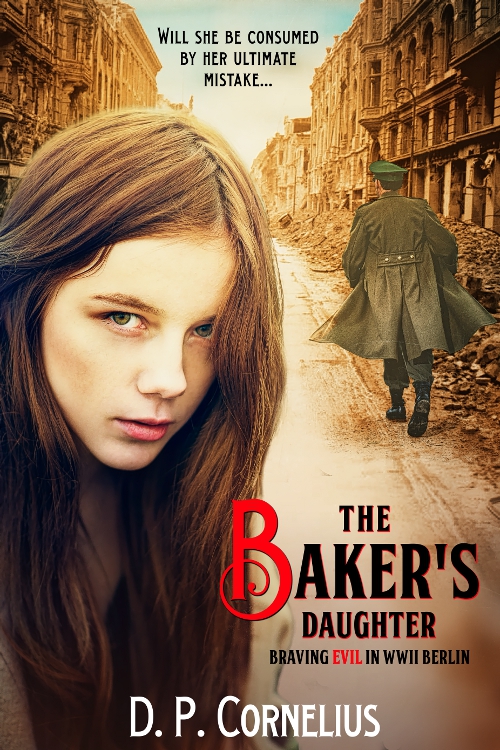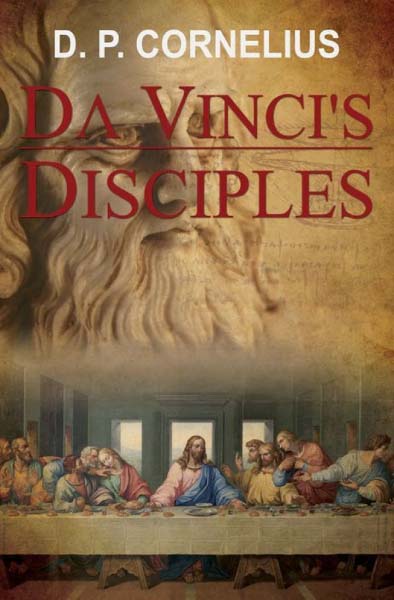Grand-Discipling
Reading these books, “The Baker’s Daughter” and “Da Vinci’s Disciples”, together and discussing these lesson plans opens up opportunities to Grand-Disciple.

The Baker's Daughter
Lesson Plan and Discussion Questions
Answering these questions will help the reader fully appreciate the significance of the historical events while highlighting the theme of sacrificial love. Look for the symbolism of God’s unconditional love at the end.
- As a young teen, Marek worked at Father Maximillian Kolbe’s Catholic monastery called, “The City of Mary,” at Niepokalanow, Poland, where The Knight newspaper was published. Why was it called a city?
- Liddy’s phone call from Munich to her Father in Berlin reveals what deep-seated longing?
- Marek’s account of how Jews were treated in Poland by the occupying Nazis is chilling. How accurate do you think his account is?
- Marek appears to be living on the edge. Give examples of why you think he was either courageous or foolhardy?
- Shy Liddy’s following Marek on her bike seems out of character. What does it demonstrate?
- Johanna Solf established her Circle resisting Nazism in 1936. What do you think her group members thought insulated them from the Nazi authorities?
- Why do you think Marek creatively used the letter “M” to win a job at the bakery?
- What character traits make Herr Keppler similar to popular stereotypes of a Nazi police officer? In what way was he decidedly different?
- What sort of risk was Klaus taking when he agreed to deliver letters from prison for Dietrich Bonhoeffer? Three guards agreed to also smuggle goods in and out. Bonhoeffer was arrested in the spring of 1943, and sent to Tegel prison for subversion, although formal charges were not made until late in his almost two year term. While there, he became engaged to Maria von Wedemeyer, but was never able to marry her. He was eventually executed by hanging at age thirty-nine at the Flossenburg concentration camp on April 9, 1945, only two weeks before liberation by American forces
- Why do you think Marek expressed a certain level of support for Nazism in front of Liddy?
- What does Renate’s physical condition portend for the future of the bakery? For Willy’s piano playing?
- What do you think was the most important thing Liddy and Marek learned about each other on the picnic?
- Air raids were common in Berlin, performed mostly by British pilots at night, with Americans focusing on defense industries during the day. Can you list some things the Germans did to counter-act them?
- Father Kolbe’s focus on love in the midst of the evil around them was a good send-off for his people. Do you have examples of when love helped you through a particularly rough time?
- Father Kolbe was canonized a saint by Pope John Paul II in 1982. Can you name what he is a saint of? Kolbe’s act of giving up his life was reported by the man whom he saved, Francis Gajowniczek, and several witnesses. An excellent resource book on the life of Father Kolbe is Forget Not Love by Andre Frossard.
- Herr Keppler comments that the Gospels don’t agree on everything. Can you name some differences? In light of the different times they were written, what is more striking—their similarities or dissimilarities?
- In his dealings with Willy, Keppler exhibits personality characteristics such as punctuality, nationalism, and perfection. When are these qualities good versus when can they turn bad?
- Describe Bonhoeffer’s Stations on the Road to Freedom. Why is the first one so critical to achieving the others?
- What Scripture passages are cited as suggested resources when our backs are against the wall with some difficult situation?
- The Elisabeth von Thadden School was resurrected after the war and still exists today near Heidelberg, Germany. For what is the school known? Visit Elisabeth-von-thadden-schule.de.
- The premise of the story is that Keppler’s heart is redeemable. Do you think there is a point where evil is so entrenched, it is beyond hope?
- In Liddy’s letter to her Grossmutter, she does not mention listening to the BBC with her father. Why might that be?
- What does Marek’s mother reflect upon to get her through the gruesome days at Ravensbruck concentration camp? See Viktor Frankl’s Man’s Search for Meaning for additional depth.
- What do you think Bonhoeffer meant by, “Confession of guilt should happen without a sidelong glance at the others who are also guilty?”
- Liddy poses a question to Keppler about what would please him the most. He avoids answering, but which of the choices do you think he would choose? How would he prioritize God, country, and family?
- Are you surprised Liddy and her parents didn’t address the possibility that Marek was Jewish before it came to a critical head? Why or why not?
- Similar to Kolbe, Renate considered giving herself up in exchange for Marek. Do you think Keppler would have accepted?
- Has fully comprehending God’s love for you freed you up from fear in your life? Do you think it makes it easier to love others?
- Have you ever had a “Barabbas moment” when you desperately wanted one thing, but were disappointed to get something else?
- When Anna showed up at the Mittendorf’s door, it could be called a “Kolbe moment.” Explain.
- Keppler was a strategic thinker. How did his attempt to trap Liddy backfire?
- Why did Keppler have such a hard time forgiving God?
- How is it that the words to Ave Maria were forboding to Renate?
- Why was it important to the story’s resolution that Liddy’s act of love happen before she knew Keppler had released Marek? Was Marek’s re-capture consistent with the times?
- How many actual historical figures woven into the story can you name? Except for Dr. Reckzeh, could we consider them all to be Christian martyrs? Remember also the building custodian, Otto Jodmin. He survived the war and later reflected on his harboring of Jews. “I simply had to do it. I did not even think about it, not at all. I just couldn’t act in any other way.” (Source: Morehouse, Roger, Berlin at War, New York: Basic Books, 2010, pg. 297)

Da Vinci's Disciples
Lesson Plan and Discussion Questions
Throughout the course of the story, a Biblical approach to the following life issues are indirectly dealt with through the experiences of the characters: competition, lying, jealousy, inventiveness, accusation, forgiveness, admiration, denial, timeliness, compassion, and love.
In addition to the many accomplishments of Leonardo Da Vinci, personality traits of many of the Disciples are discussed.
Chapter 1
- With what two major things is Leonardo Da Vinci’s mind pre-occupied at this time?
- After a few glimpses of his personality, how would you describe him?
- What is behind the concerns that Dom has about his relationship with his father?
Chapter 2
- Give examples of what Dom said to his father that he knew deep down were not right.
- How would you describe Dom’s relationship with Romolo?
- What invention do you suspect may re-appear later in the story?
- How did Dom’s thinking “outside the box” save the day?
Chapter 3
- How is intrigue introduced into the story by the visit of the Frenchman?
- How does Dom foresee himself providing more value to Leonardo?
- What did Dom learn about Fiorella that was encouraging? What was upsetting?
Chapter 4
- What was Father Vincenzo so concerned about?
- What affirmation did Dom get that he was relied upon to do research of the Disciples?
- What hints are there that Romolo is up to mischief?
- What was Leonardo’s point about the moth, the candle flame, and light?
Chapter 5
- Why did Dom and Fiorella sneak into St. Ambrose to research the Bible?
- How big was the wall at the refectory upon which The Last Supper was to be painted?
- How was Leonardo different from Dom’s previous teachers?
- What did a clock spring have to do with a self-propelled cart?
Chapter 6
- What responsibilities did Leonardo have for the Festival of St. Michael?
- Why did Leonardo want Salai up on a stick? What role did he play instead?
- Describe some of the painting techniques Romolo discusses with Dom.
- What caused Dom to think, I am not about to take bread away from a young girl of the street?
Chapter 7
- Why was real historical figure Girolamo Savonarola introduced to the story?
- How was a toad used to illustrate one of the marvels of nature?
- What is the account of the blackbird intended to illustrate?
- Would you have jumped off a cliff as Dom did? Why or why not?
- What other invention showing the breadth of Leonardo’s inventiveness was important during the trial of the glider?
- What had Dom’s research of disciples John and Thomas revealed?
Chapter 8
- Dom suspects sabotage regarding failure of the glider. Explain.
- Why does Fiorella get so mad at him?
- When the spring cart also fails, what does Leonardo think?
- What does he reveal in his disappointment?
Chapter 9
- Despite some failures, what successes was Dom able to reflect upon?
- How did his earlier failures lead him to one made by the great Da Vinci?
- How did Leonardo and Fiorella react to Dom’s return?
Chapter 10
- What traits of the Disciples are revealed in Leonardo’s painting to this point?
- What was the ‘what if’ thinking around a possible flying machine and a military tank?
- When some drawings go missing, who do you suspect?
Chapter 11
- How is Romolo able to turn Dom into a suspect?
- How does Romolo react to Fiorella’s accusing him of past sabotage?
- How do we know Leonardo considers Dom a suspect?
- What from Dom’s past prompts him to become inventive?
- Leonardo is looking for a model for Jesus. Do you know any family or friends that might qualify?
Chapter 12
- What about Dom’s dream of inventions in the dungeon was different from real life?
- What revealed to Dom that the master cared for him?
- Was Dom able to control his emotions after his eavesdropping Romolo’s conversation with Leonardo? To what extent?
Chapter 13
- Which surprised you more – Dom’s confession to the master, or his immediate accusation of Romolo? Why?
- As Romolo wandered the town upset about what Leonardo had told him, to what extent did his actions resemble those of the disciple Peter?
- How did the Apostle Paul’s letter to Philemon apply to the situation?
Chapter 14
- After the fight, in what way did Fiorella prove to be the wisest of the three of them?
- How did Leonardo’s moth and candle story apply?
- What evidence is there that Romolo is changing as a person?
Chapter 15
- How did Dom’s observations help solve the puzzle of the missing drawings?
- Why does Fiorella petition to have Dom paint the disciple John?
- Name two reasons the master announced that Romolo would be the first paint on the wall.
- Relate how the subject of turning jealousy into admiration came up.
Chapter 16
- What did Dom’s inventive mind have to do with Romolo’s mother?
- What was Romolo’s suggestion to Dom for improving his painting technique?
- How did Dom’s ideas about painting John’s hands turn into reality?
- What evidence finally nailed down the issue of the missing drawings?
Chapter 17
- Who were the various people offered for the selection of the model for Jesus?
- Do you agree with Leonardo’s selection? Why or why not?
- Sum up the tone of the final scripture passage (1 Corinthians 2:9) that they all rallied around.
